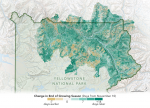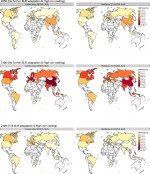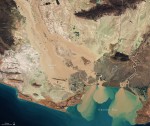
Tuesday, March 24th, 2020
Tropical forest ecosystems are an important part of the global carbon cycle as they take up and store large amounts of carbon dioxide. It is uncertain, however, how much these forests’ ability to take up and store carbon differ between forests with high vs. low species richness. New International Institute for Applied Systems Analysis (IIASA)

Tuesday, March 17th, 2020
The bison population has grown rapidly during the last two decades in Yellowstone National Park. This creates complex situations for wildlife managers when the animals follow good grazing opportunities beyond the boundaries of the park and come into contact with surrounding communities. A NASA study has now found a link between climate change effects on

Tuesday, March 10th, 2020
Similarly to how bats use echolocation to orient themselves with their surroundings, mathematicians have found that the same can be done with microphones and a speaker on a drone with the help of algebra and geometry. This signal processing research has potential applications for people, underwater vehicles and even cars, said Mireille “Mimi” Boutin, a

Tuesday, March 3rd, 2020
Drones are commonly known for flying in the sky, but a new breed is rolling around on the ground and swimming in the ocean. Aquiline Drones (AD) will be powering GuardBot’s spherical and amphibious robotic vehicles via the AD Cloud. “Our new alliance with Aquiline Drones now gives us the ability to program our bots

Monday, February 24th, 2020
NASA is partnering with the New Zealand Ministry of Business, Innovation and Employment, New Zealand Space Agency, Air New Zealand and the University of Auckland to install next-generation Global Navigation Satellite System (GNSS) reflectometry receivers on passenger aircraft to collect environmental science data over New Zealand. The program is part of NASA’s Cyclone Global Navigation

Tuesday, February 18th, 2020
The Arctic is one of the fastest warming places on the planet. As temperatures rise, the perpetually frozen layer of soil, called permafrost, begins to thaw, releasing methane and other greenhouse gases into the atmosphere. These methane emissions can accelerate future warming—but to understand to what extent, we need to know how much methane may

Tuesday, February 11th, 2020
Antarctica’s Thwaites Glacier has been in the spotlight in recent years, as scientists have undertaken a multi-part international project to study the vast glacier from all angles. The urgency stems from observations and analyses showing that the amount of ice flowing from Thwaites—and contributing to sea-level rise—has doubled in the span of three decades. Scientists

Tuesday, February 4th, 2020
A study revealing how the climate will shift by 2050 in major cities around the globe has been released by apartment rentals platform, Nestpick.com. To understand how some of the most popular cities in the world will be affected by climate change, the apartment platform set out to determine how potential temperature shifts, water shortages

Tuesday, January 28th, 2020
Rising sea levels, a direct impact of the Earth’s warming climate, is intensifying coastal flooding. The findings of a new study show that the projected negative economy-wide effects of coastal flooding are already significant until 2050, but are then predicted to increase substantially toward the end of the century if no further climate action on

Tuesday, January 21st, 2020
Heavy rainfall has triggered flooding in southern Iran, particularly in the Sistan and Baluchestan, Hormozgan and Kerman provinces. The downpour has led to blocked roads and destroyed bridges, crops and houses, displacing thousands of people. This image, captured by the Copernicus Sentinel-2 mission, shows the extent of the flooding in the Sistan and Baluchestan province
